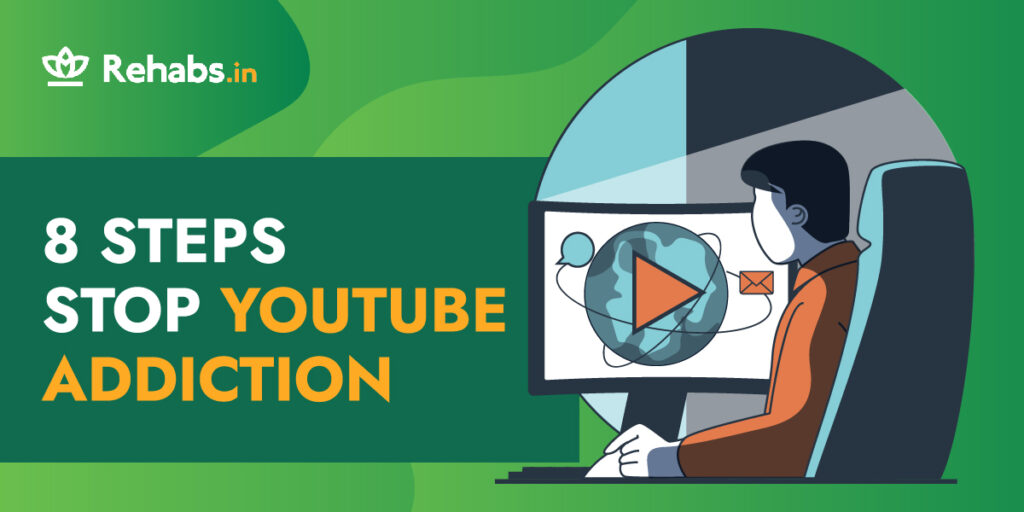8 Steps stop youtube addiction

YouTube addiction can stealthily creep into our lives, devouring precious hours and altering our routines. It’s not just about watching entertaining videos anymore; it’s about recognising when it becomes a habit we struggle to control. The craving to scroll through endless videos can sometimes morph into an addiction that impacts our productivity, mental health, and overall well-being. This article aims to shed light on this issue and offer eight practical steps to combat and conquer YouTube addiction.
The prevalence of YouTube addiction has skyrocketed in recent years. The platform’s captivating content and endless recommendations often lure users into extended, unproductive screen time. This addiction can subtly affect our lives, leading to procrastination, neglect of responsibilities, and disrupted sleep patterns. Every day, approximately one in every five smartphone users dedicates more than 4.5 hours to their devices on average. You may be addicted to your phone in general.
Overcoming addictive behaviors, regardless of the platform, is crucial for maintaining a healthy lifestyle. It’s not merely about cutting down screen time but also about reclaiming control over our habits and dedicating time to more meaningful activities.
This article aims to guide individuals struggling with YouTube addiction by providing actionable steps to regain control. The primary goal is to empower readers with practical strategies to curb their YouTube consumption and regain a balanced approach to technology use.
Step 1: Acknowledge the Addiction
Acknowledging YouTube addiction is the pivotal first step towards recovery. Recognizing the impact it has on daily life is crucial in initiating change. Signs of addiction to online video content can include spending excessive hours on YouTube, neglecting other responsibilities, feeling anxious or irritable when unable to watch, and prioritizing YouTube over social interactions. Self-awareness is key. Understanding the grip that YouTube has can motivate individuals to seek change and embark on the path to recovery.
Step 2: Set Clear Goals
Establishing clear and realistic goals for reducing YouTube consumption is essential. These goals serve as guiding posts in breaking the addictive cycle. Goal-setting provides direction and motivation. Crafting SMART goals (Specific, Measurable, Achievable, Relevant, Time-bound) helps in tracking progress effectively. For instance, setting a goal to limit daily YouTube use to 30 minutes and gradually decreasing it over weeks can be a SMART goal.
Step 3: Create a Schedule
Structuring a daily or weekly schedule helps in allocating specific times for YouTube use while balancing other activities. Time management strategies, such as setting dedicated hours for YouTube or using timers to restrict usage, aid in adhering to the schedule. Balancing work, hobbies, socializing, and leisure is crucial for a well-rounded routine.
Step 4: Use Technology Tools
Leveraging technology tools can assist in monitoring and limiting YouTube usage. Various apps and browser extensions are designed specifically to manage screen time. These tools offer features like setting usage limits, blocking specific sites, and providing reports on time spent online. Setting up notifications and reminders to take breaks while using YouTube can help in developing healthier habits.
Step 5: Identify Triggers
Understanding the triggers that lead to excessive YouTube consumption is crucial. Common triggers include stress, boredom, loneliness, or the desire for escapism. Identifying personal triggers empowers individuals to recognise moments when they’re vulnerable to excessive screen time. Strategies such as mindfulness, journaling, or seeking professional guidance aid in managing and addressing these triggers effectively.
Step 6: Find Alternatives
Discovering alternative activities is pivotal in reducing YouTube consumption. Engaging in hobbies, exercising, reading, or socializing provides healthier outlets for leisure time. Exploring new interests not only fills the void left by YouTube but also enriches life experiences. Investing time in fulfilling and meaningful pursuits leads to a more balanced and gratifying lifestyle.
Step 7: Seek Support
Seeking support from friends, family, or support groups can significantly aid in combating YouTube addiction. Sharing goals and progress with an accountability partner fosters commitment and provides encouragement along the journey. Professional support, such as therapy or counseling, offers specialized guidance in overcoming addictive behaviors associated with excessive screen time.
Step 8: Reflect and Adjust
Regular self-reflection is essential. Evaluating progress, recognizing challenges, and celebrating achievements fuels personal growth. Flexibility is key. Adjusting goals and strategies based on experiences ensures continuous improvement. Recognizing the iterative nature of the recovery process emphasizes the importance of ongoing self-assessment and adaptation.
In conclusion, conquering YouTube addiction involves a multifaceted approach encompassing self-awareness, goal-setting, time management, identifying triggers, adopting alternative activities, seeking support, and continual self-assessment. By implementing these practical steps, individuals can regain control of their screen time, leading to a more balanced and fulfilling lifestyle.
Remember, progress might not be linear, but every step taken towards breaking free from YouTube addiction is a significant achievement towards a healthier digital life.
Sources:
Balakrishnan, J., & Griffiths, M. D. (2017). Social media addiction: What is the role of content in YouTube?. Journal of behavioral addictions, 6(3), 364-377.
de Bérail, P., Guillon, M., & Bungener, C. (2019). The relations between YouTube addiction, social anxiety and parasocial relationships with YouTubers: A moderated-mediation model based on a cognitive-behavioral framework. Computers in Human Behavior, 99, 190-204.
Howarth, J. (2023, December 4). Time spent using smartphones (2024 statistics). Exploding Topics. https://explodingtopics.com/blog/smartphone-usage-stats
Jean, E. (2021, July 9). How to get over your YouTube addiction. The Daily Californian. https://dailycal.org/2021/07/09/how-to-get-over-your-youtube-addiction/













